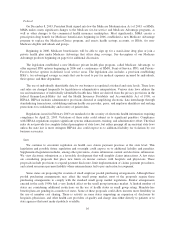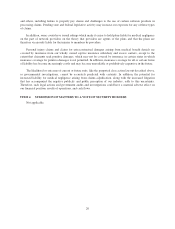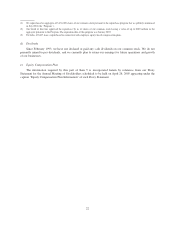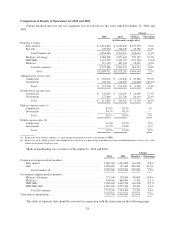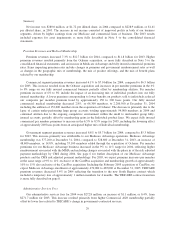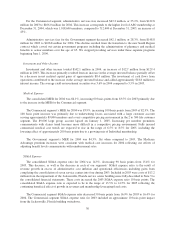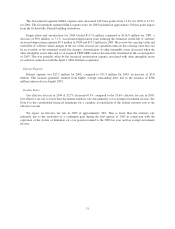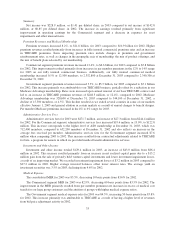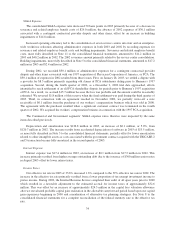Humana 2004 Annual Report Download - page 34
Download and view the complete annual report
Please find page 34 of the 2004 Humana annual report below. You can navigate through the pages in the report by either clicking on the pages listed below, or by using the keyword search tool below to find specific information within the annual report.ITEM 7. MANAGEMENT’S DISCUSSION AND ANALYSIS OF FINANCIAL CONDITION AND
RESULTS OF OPERATIONS
The consolidated financial statements of Humana Inc. in this document present the Company’s financial
position, results of operations and cash flows, and should be read in conjunction with the following discussion
and analysis. References to “we,” “us,” “our,” “Company,” and “Humana” mean Humana Inc. and its
subsidiaries. This discussion includes forward-looking statements within the meaning of the Private Securities
Litigation Reform Act of 1995. When used in this filing and in future filings with the Securities and Exchange
Commission, in our press releases, investor presentations, and in oral statements made by or with the approval
of one of our executive officers, the words or phrases like “expects,” “anticipates,” “intends,” “likely will
result,” “estimates,” “projects” or variations of such words and similar expressions are intended to identify
such forward–looking statements. These forward–looking statements are not guarantees of future performance
and are subject to risks, uncertainties, and assumptions, including, among other things, information set forth in
the “Cautionary Statements” section of this document.In light of these risks, uncertainties, and assumptions, the
forward–looking events discussed in this document might not occur. There may also be other risks that we are
unable to predict at this time. Any of these risks and uncertainties may cause actual results to differ materially
from the results discussed in the forward–looking statements.
Overview
Headquartered in Louisville, Kentucky, Humana Inc. is one of the nation’s largest publicly traded health
benefits companies, based on our 2004 revenues of $13.1 billion. We offer coordinated health insurance coverage
and related services through a variety of traditional and Internet-based plans for employer groups, government-
sponsored programs, and individuals. As of December 31, 2004, we had approximately 7.0 million members in
our medical insurance programs, as well as approximately 1.7 million members in our specialty products
programs. During 2004, 43% of our premiums and administrative services fees were derived from contracts with
the federal government, including 17% related to our TRICARE contracts and 15% related to one contract in
Florida with the Centers for Medicare and Medicaid Services, or CMS. Additionally, 37% of our premiums and
administrative services fees in 2004 were earned from contracts with employer groups and individuals covering
members located in Texas, Illinois, Florida, Kentucky and Ohio.
We manage our business with two segments: Commercial and Government. The Commercial segment
consists of members enrolled in products marketed to employer groups and individuals, and includes three lines
of business: fully insured medical, administrative services only, or ASO, and specialty. The Government segment
consists of members enrolled in government-sponsored programs, and includes three lines of business: Medicare
Advantage, TRICARE, and Medicaid. We identified our segments in accordance with the aggregation provisions
of Statement of Financial Accounting Standards No. 131, Disclosures About Segments of an Enterprise and
Related Information which is consistent with information used by our Chief Executive Officer in managing our
business. The segment information aggregates products with similar economic characteristics. These
characteristics include the nature of customer groups and pricing, benefits and underwriting requirements.
The results of each segment are measured by income before income taxes. We allocate all selling, general
and administrative expenses, investment and other income, interest expense, and goodwill, but no other assets or
liabilities, to our segments. Members served by our two segments often utilize the same medical provider
networks, enabling us to obtain more favorable contract terms with providers. Our segments also share overhead
costs and assets. As a result, the profitability of each segment is interdependent. We are somewhat unique in our
industry by having revenues and enrollment approximately split between Commercial and Government segments,
drawing revenues from group, individual, Medicare, Medicaid and military business lines. We believe that it is
difficult to time market cycles and external influences on various parts of our businesses. By remaining
committed to varied lines of business with a long-term view, we may benefit through short-term market cycles.
We believe our diversification across segments and products allows us to increase our chances of success.
24




